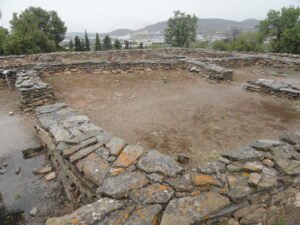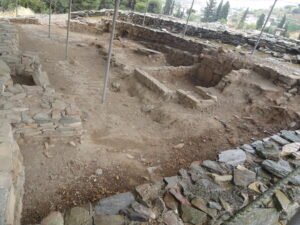 The archaeological site of Dimini is located at the northern edge of the village it was named after, just a few kilometers west of the Greek port city of Volos. However, the ancient name of the settlement at Dimini is unknown, although there is speculation that it might have been the Mycenaean city of Iolkos, probably best known today through its depiction as the home of the legendary Jason, as well as the port from which he and his fellow Argonauts set sail on the Argos to recover the Golden Fleece. On the other hand, there was also an ancient settlement within modern Volos which some claim as ancient Iolkos.
The archaeological site of Dimini is located at the northern edge of the village it was named after, just a few kilometers west of the Greek port city of Volos. However, the ancient name of the settlement at Dimini is unknown, although there is speculation that it might have been the Mycenaean city of Iolkos, probably best known today through its depiction as the home of the legendary Jason, as well as the port from which he and his fellow Argonauts set sail on the Argos to recover the Golden Fleece. On the other hand, there was also an ancient settlement within modern Volos which some claim as ancient Iolkos.
The oldest layers of Dimini date back to the middle of the 5th millennium BCE, the Late Neolithic period. This was around the time of the later years of the much older settlement at Sesklo, which was just 4.5 kilometers to the west. Most of the structures on the mound of the northwestern excavation area at Dimini date back to this early period. The two key buildings in the center of the mound were the central court (below, left) and Megaron, or Great Hall (below, right).


The bases of several other impressive structures can also be found on the mound.




A second large excavation area can be found just 50 meters southeast of the Neolithic mound, and the structures there date to the later Mycenaean period of the second millennium BCE.


The fact that Dimini was an important site in Mycenaean times is clear from the large tholos tombs found at the site. One of them (called the “Toumba”) is on the northwestern slope of the mound in the northwest of the site.


Another large tholos tomb (dubbed “Lampiospito”) can be found 200 meters to the west of the Toumba.


Some artifacts found at Dimini can be seen on display at the Athanasakio Archaeological Museum of Volos.




Tips for the Visitor
The village of Dimini can be reached from the nearby city of Volos by taxi or even by walking. Volos is about an hour by train from Larissa, which is on the Athens-Thessaloniki train line.
Location Map
